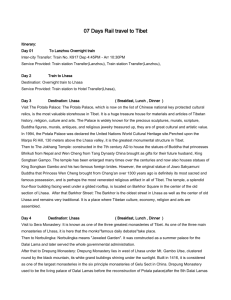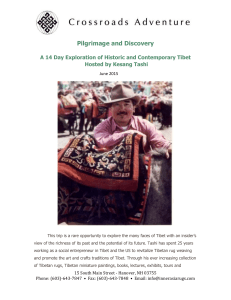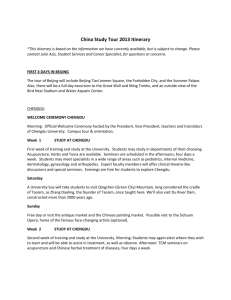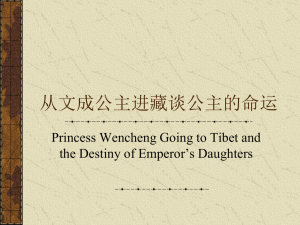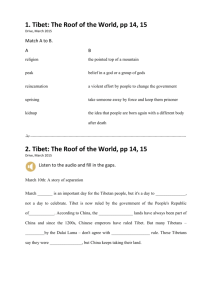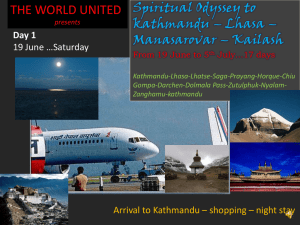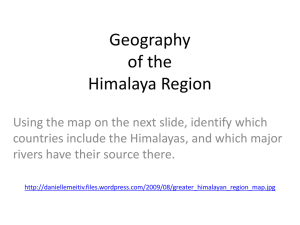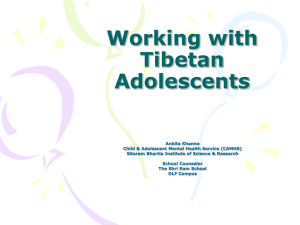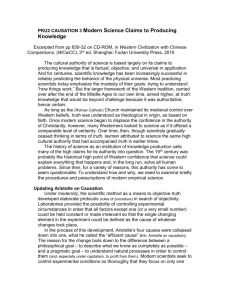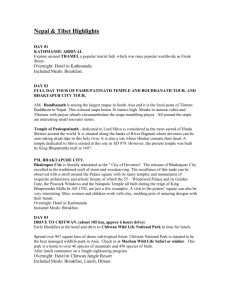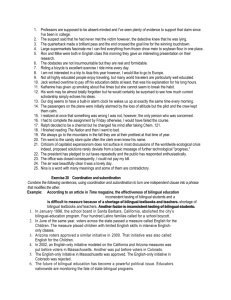Details - Insight Nepal Tours & Travel
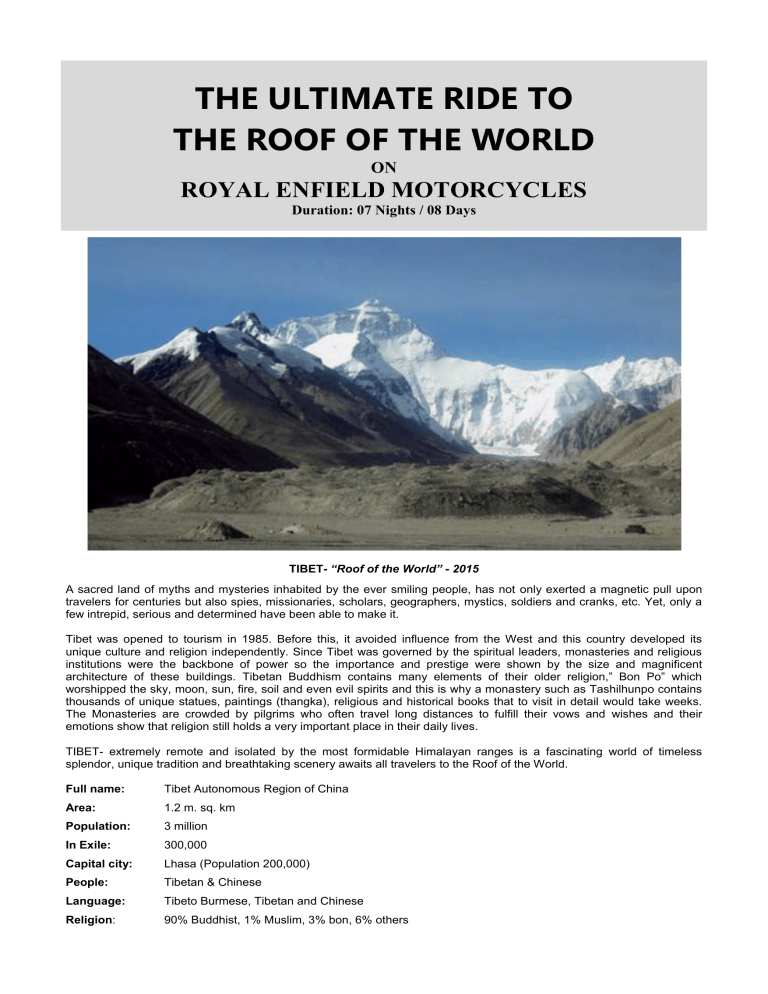
THE ULTIMATE RIDE TO
THE ROOF OF THE WORLD
ON
ROYAL ENFIELD MOTORCYCLES
Duration: 07 Nights / 08 Days
TIBET“Roof of the World” - 2015
A sacred land of myths and mysteries inhabited by the ever smiling people, has not only exerted a magnetic pull upon travelers for centuries but also spies, missionaries, scholars, geographers, mystics, soldiers and cranks, etc. Yet, only a few intrepid, serious and determined have been able to make it.
Tibet was opened to tourism in 1985. Before this, it avoided influence from the West and this country developed its unique culture and religion independently. Since Tibet was governed by the spiritual leaders, monasteries and religious institutions were the backbone of power so the importance and prestige were shown by the size and magnificent architecture of these buildings. Tibetan Buddhism contains many elements of their older religion,” Bon Po” which worshipped the sky, moon, sun, fire, soil and even evil spirits and this is why a monastery such as Tashilhunpo contains thousands of unique statues, paintings (thangka), religious and historical books that to visit in detail would take weeks.
The Monasteries are crowded by pilgrims who often travel long distances to fulfill their vows and wishes and their emotions show that religion still holds a very important place in their daily lives.
TIBET- extremely remote and isolated by the most formidable Himalayan ranges is a fascinating world of timeless splendor, unique tradition and breathtaking scenery awaits all travelers to the Roof of the World.
Full name: Tibet Autonomous Region of China
Area: 1.2 m. sq. km
Population:
In Exile:
Capital city:
3 million
300,000
Lhasa (Population 200,000)
People:
Language:
Religion :
Tibetan & Chinese
Tibeto Burmese, Tibetan and Chinese
90% Buddhist, 1% Muslim, 3% bon, 6% others
Government: Occupied by China in 1949/1950
Currency:
Geography:
Climate:
Yuan (Y 6.15 = US$ 1.00) as of 25/08/2014
Tibet has border with India, Nepal, Sikkim, Bhutan and Burma
Spring (May to June) – Best weather condition, May to Mid September Winter – (October to April)
What to wear: Light weight clothing is recommended for May to June, Warm garments are required from September to April. An umbrella or a raincoat is a must for the summer season.
Voltage: Standard voltage only 220 volts.
DETAILED ITINERARY
Day 01: Ride Kathmandu to Nyalam (approx. 158 Km)
Negotiate traffic out of the Kathmandu city to the Ringroad cross section - Koteshwor. From here, follow the newly constructed highway to Bhaktapur (Approx. 12 Km from Kathmandu). The ancient Bhaktapur City or the “City of Devotees” situated at an altitude of 1,401 m, 12 kilometers east of Kathmandu. Bhaktapur covers an area of 4 square miles and is shaped like a conch shell. Pottery and weavings are its traditional industries.
Continue cruising past Bhaktapur to Dhulikhel (Approx. 18 Km from Bhaktapur) via Jagati, Sanga & Banepa passing road side settlements and terraced farmlands.
Dhulikhel, situated at an elevation of 1550 meters with panoramic view of the Himalayas is a small Newari town and is famous for its scenic beauty and old tradition. It offers magnificent views of the Himalayas from
Mt, Karyolung in the east to Mt. Himalchuli to the west the twin crest of Mt. Langtang in the west to the Mt.
Everest in the east can be clearly viewed in a clear day. Dhulikhel is ideal for snow-capped peaks, sunrise, sunset and it is different from any other and is one of the best sites to watch the sunrise over the Himalayas.
Later continue ride towards Dolalghat.
After few kilometers from Dhulikhel the highway drops in to the winding road with the beautiful sceneries of terraced fields and forested trails alongside small settlement to “Zero Kilo”. From here road bifurcates. North road leads to Melamchi Bazaar and South road leads to Kodari. Head south and continue ride towards
Dolalghat - the lowest point on the entire road at 634m (Approx.25 Km from Dhulikhel). Dolalghat is situated at the confluence of Indrawati and Sunkoshi rivers on the Araniko highway and this place is apparently famous for the fish from its rivers.
Cross the bridge and slowly ascend on a winding road for a few kilometers and after
2 kilometers turn a steep right to come up to the ridge. (Note: At the turning, the straight road leads to Chautara so one needs to take the full right turn and continue on the highway).
From the ridge, descend to Chehere and continue cruising along with the fast flowing
Bhote Koshi River on the right side and beautiful views of terraced fields, forests and small settlements all the way to the
Sukute (Approx. 14 Km from Dolalghat).
Continue ride another approx. 50 km to the
Kodari (Nepal – Tibet Border).
Upon arrival at Kodari, the last border town, complete Nepali Immigration formalities and cross the friendship bridge. Complete Chinese
Immigration and met by guide and driver from Tibet. Proceed for China
Custom clearance for the motorcycles and after completion, load up the personal gears on the waiting Land
Cruiser and the spare parts on the truck and ride 20 minutes (8 kilometers) to Zhangmu.
Zhangmu: Located at an altitude of 2300 m and known to Nepali as Khasa, hangs on a cliff face, its boomtown architecture having a temporary look. Even the monastery roofs are sheathed in corrugated iron sheets. Here we obtain travel pass for vehicles from the transport office and then ride for an hour through the
Tibetan landscape to Nyalam gaining an altitude of 1450 meters within a short span of 30 kms.
Upon arrival, check into the Guest House.
Overnight at the Guest House
Day 02: Ride Nyalam to Tingri (Approx. 152 Km)
Ride to the highest plateau of the world with typical view of the Tibetan landscape offering a sheer feeling of standing on the roof of the world. Firstly cross the Nyalam Pass (3,800m) and ascend steeply to Thong La
(5,050m), in about 2- 3 hours. From here, weather permitting, there is breathtaking panorama of beautiful
Himalayan ranges including Mt. Everest (8,848m) and Mt. Shishapangma, but dwarfed by the vastness of the Tibetan plateau.
After a brief stop, we ride past a discreet pass Lalung La (5200 m) marked by an array of prayer flags and then continue on the friendship highway to Tingri.
Upon arrival check in to the guest house. (Note : This is a short day to allow time for acclimatization)
Lunch at the Guest house
PM : FREE TO WALK AROUND THE BAZAAR OR JUST REALX ENJOYING THE MOUNTAIN VIEW.
Overnight at the Guest House
Day 03: Ride Tingri to Shigatse (292 Km)
After breakfast ride 70 km to Shegar.
Shegar: Also called New Tingri, surrounded by Mountains, is another town that lies in the shadow of a great fortress. Even in ruins it is majestic. Seeming to grow out of the craggy brown rock, its sinuous wall bristles with watchtowers like stegosaurus spines. Isolated in 1855 by marauding Nepalese in search of booty, the
Gurkhas cut off the dzong’s water supply and settled in for a long siege. Shegar proper has little to recommend it except the highest post office in China.
Continue ride further 100 km on a very scenic drive crossing the Gyatso La (5,220m), the highest pass enroute to Lhasa. From here we descend to the settlement of Lhatse. We have a choice to either continue on the friend ship highway by crossing two smaller passes to Shigatse or to take a diversion and follow the simpler route following the river. However, the guide shall advise us on road conditions and will take the route as per his advice.
Shigatse is the second largest town in Tibet and the capital of Tsang, lying 354km west of Lhasa at an altitude of 3810 m. From here follow the Northern route to Lhasa via Trakdruka, Nyemo, Chusul and
Nyethang.
Upon arrival check in to the guest house
Overnight at the guest house
Day 04: AM: Sightseeing Tour of Tashilhunpo Monastery & Ride to Gyantse with Sightseeing of Kumbum
*Note: Process bike for observation (It has been made mandatory that all Motorcycle be sent for examination to the Police headquarters of Shigatse, who will recheck all the permits from Lhasa
Police Headquarters, Custom clearance etc and then issue the pass for the motorcycles to travel through Shigatse perfect ire and also issue a temporary local driving licence to all motorcycle riders as per the list and details.
While the permits are being taken care of, proceed for the sightseeing tour of the Panchen Lama’s
Tashilhunpo Monastery.
Founded in 1447 by Gendun Drup, the first Dalai Lama. It is the seat of the
Panchen Lama who is second to the Dalai Lama in Tibetan Buddhist Hierarchy. The 5th Dalai Lama in declared that his teacher, then the Abbot of Tashilhunpo, who a manifestation of the Buddha Amitabha and the Panchen Rinpochhe. Tashilhunpo has one of the world’s largest statues - a 9 storeyed gilded bronze statue of Maitriya, the future Buddha.
After the sightseeing tour continue the ride to Gyantse. Gyantse is approximately 90 km Southwest of Lhasa.
It still retains the charm of a traditional Tibetan town untouched by modern expansion. It made world headlines in 1904 when Colonel Young husband, who led British Expedition to Tibet, defeated the Tibetan army there. As a crossroad on the principle trade route to India, it used to be renowned for the excellence of its carpets. The compound, encircled by an impressive wall, once contained 19 monasteries, presided over by the still intact fortress perched atop a nearby mountain. Here one visits the Kumbum Stupa and Pelkhor
Chode Monastery.
After lunch, proceed for the sightseeing tour of Gyantse Kumbum, one of the most unique and magnificent buildings in Tibet consisting of 6 storeys complete with a Buddhists Hall and a prayer hall. It has 112 chapels and its walls are adorned with religious paintings. Built in the 15 th century, it has withstood all battles and revolutions since. We also visit the Pelkhor Chode Monastery l ocated near the Khumbum, it was founded in the 15th century. It has been remarkably well preserved and many of the statues and paintings inside it date back to the time of its founding.
Overnight at Guest House
Day 05: Ride Gyantse to Lhasa (3,650m) 261 Km via Lake Yamdrok
S et out of Gyantse for Nagartse (100 kms) near Lake Yamdrok passing the Simi La (4200 m) and driving on a trail with fantastic views of the turquoise blue waters of the manmade lake caused by the dam for the hydro project. Later we also cross the Karo La (5010 m) and then ride to Nagartse, a small village near the
Yamdrok Lake and an ideal place for a lunch stop.
Then drive along the picturesque trail of the colorful
Lake Yamdrok , the Tibetan lifeline river Brahma Putra
(Yarlung Tsangpo).
Yamdrok Tso or Turquoise
Lake: A lake of a glaring blue that radiates a near mystical charm. It is about 240 kms in circumference and is more like an Island sea. There are Yak herders around and the lake itself supports a population of scale less fish in its non-saline waters. It is about 124 km from Lhasa.
Later we ascend on a dirt track to Kamba La (4,794m) and have an opportunity to meet the Yak Herders with their finely decorated Yaks and Tibetan Mastiffs. A great photo opportunity and one can take pictures on a
Yak or with a bunch of decorated Tibetan Mastiffs for a fee.
From here we descend to the main road head before embarking on the grand finale entrance to the Lhasa
City.
Lhasa: The capital of Tibet at an altitude of 3650m is situated on the north bank of the Kyichu River in the province of U (central Tibet). Two high craggy hills stand up in isolation from the valley floor. One, Red Hill, is topped by the Potala Palace and the other, Chockpori or Iron Hill, is crowned by a tall antenna.
Lhasa in Tibetan means "Place of the Gods" and Potala Palace " the residence of the Dalai Lama (the god king), is the earthly representation of the celestial Palace of Avaloketswora, the Buddha of infinite compassion whose incarnation in the human form is believed to be t he Dalai Lama. As Tibet’s political, religious and cultural centre it is a city truly blessed by the gods, where life is unhurried, is people jovial and yet remaining staunchly independent.
Lhasa consists of two district parts consisting of different architecture, population and lifestyle. Old Lhasa, the Tibetan section, centers on The Jokhang Temple. Its streets are narrow, between white washed stone houses whose walls slope inward as they rise. Windows are framed in black trapezoids, with protruding fan shaped eaves above. Many houses have brightly painted woodwork. The Chinese section was built in the last 30 years around the base of the Potala. It is characterized by straight, broad streets and utilitarian buildings that house Chinese style department stores and all kinds of government houses. A Revolutionary
Museum below the Potala displays the evidence of Chinese who brought economic and social change during the past 30 years.
In spite of its forced pace of modernization, Lhasa has not lost its soul. It is a friendly city where a Tibetan will always return a smile.
Upon arrival at Lhasa check in to the hotel. Rest of the day is free to relax or explore around the town.
Overnight at the Hotel
Day 06: Sightseeing tour of Lhasa / Potala Palace
Sightseeing tour at Potala Palace: This legendary palace built atop a single hill is synonymous with Tibet.
First foremost king, Songtsen Gompo, it was expanded to its present structure during the 17th century by the
5 th Dalai Lama. This 13 storey, 1000 room citadel served as the headquarters of the former "church-state" of
Tibet and was home to successive Dalai Lama who, from the latter half of the 18th century, used it as their
Winter Palace.
Lunch at the Hotel or at a local restaurant
In the afternoon, visit the Jokhang Temple: Situated in the heart of old Lhasa, it houses Tibet’s most precious religious relic, a golden Shankyamuni Buddha which was brought as a gift by the Chinese Princess
Wen Cheng on the occasion of her wedding to the Tibetan King, Songtsen Gompo. Surrounding the Jokhang
Temple is the bustling Barkhor market place, which is the religious and social focus of Lhasa. This spiritual centre of Tibet is also the heart of Lhasa.
Overnight at the Hotel
Day 07: AM: Sightseeing Tour of Drepung Monastery / PM: Sera Monastery
After breakfast met by the guide at the hotel lobby and proceed for the sightseeing tour of Drepung
Monastery. Drepung Monastery is located on the Gambo Utse Mountain, five kilometers from the western suburb of Lhasa.
Drepung is one of the great three Gelukpa university monasteries of Tibet. It was founded in 1416 by
Jamyang Choge Tashi
Palden, one of
Tsongkhapa’s main disciples, and it was named after the sacred abode in South India of
Shridhanyakataka.
After the sightseeing tour of Drepung
Monastery ride back to the Hotel in Lhasa
After lunch proceed for the sightseeing tour of Sera Monastery
PM: Visit Sera Monastery: 5 kms (3 miles) north of Lhasa. Sera setting are one of Lhasa’s prettiest. Once a community of more than 5,000 monks, it was a virtually extinguished by the
Chinese. The restored monastery sits below the brow of hill on which
Tsongkhapa built a hermitage and spent several years meditating. One of the monk’s disciples began building Sera in
1419, completing it a few years later.
After the sightseeing tour return to the hotel
Rest of the day is free to relax or explore around the city.
Overnight at the Hotel
Day 08: Depart for onward Destination
After breakfast depart for onward destination.
***END OF ARRANGEMENTS***
THE COST FOR
THE ULTIMATE RIDE
TO THE ROOF OF THE WORLD
(DURATION: 07 NIGHTS / 08 DAYS)
THE COST INCLUDES:
Tibet Visa fees and Documentation of USD 114.00.00 per person for all nationals except US nationals who pay an extra USD 85.00 per person (subject to change)
Hire of 500 CC Classic Royal Enfield Motorcycles (The Desert Storm) for the entire trip.
Cost of fuel for the motorcycles for the entire trip.
Services of an experienced Road captain on Motorcycle and Mechanic from Nepal, their accommodation, meals and daily wages.
Back up support of a mini bus to carry support staff, spare parts and clients personal baggage from Kathmandu /
Kodari pre Tibet Tour.
Poterages at the Kodari (Tibet border) to transfer the equipments and spare parts from Nepal side to Tibet side
(across the friendship bridge) and vice versa pre and post Tibet Tours
Support of Japanese Made Land cruiser inside Tibet only (Kodari / Lhasa) to carry personal gears, Pillion rider if any), guide from Tibet + Mechanic from Nepal
Documentation for Tibet travel permit.
Services of a knowledgeable Tibetan Guide from Lhasa Agency.
Permit for Motorcycles to enter Tibet.
Overnights stay at Nyalam and Tingri as per itinerary will be in best available Guest house / Lodges with common baths or Attached Baths (if available), inclusive of daily breakfast.
Accommodation in Shigatse, Gyantse and Lhasa in standard 3 star OR 4 Star on Hotels (Which ever applicable) inclusive of Breakfast.
All monastery entrance fees during sightseeing tours as per the itinerary.
Support of a High Altitude Portable Chamber (Gamow bag) to be used in case of emergencies and Oxygen canisters (Chinese make) will be available in the Landcruiser.
Costs to transfer of Motorcycles from Lhasa to Kodari border in a private truck accompanied by the road captain and the mechanic inclusive of their daily allowance and meal and accommodation.
Transfer of bikes and spare parts from Kodari border to Kathmandu, Nepal in a private truck accompanied by the road captain and the mechanic, inclusive of their daily allowance and meal and accommodation.
THE COST EXCLUDES:
Nepal entry & and re-entry visa fee (if applicable)
Tibet visa fee supplement for US Nationals of US $. 85.00 Per person if applicable (Subject to Change)
Airfare for sector Lhasa / Kathmandu (Which ever applicable at the time of booking) a) Delta Class (D) USD 731.00 (648+83) per person b) Bravo Class (B) USD 598.00 (515+83) per person
(Subject to Change)
(Subject to Change) c) Mike Class (M) USD 563.00 (480+83) per person (Subject to Change)
Hotel Accommodation and meals in Kathmandu.
Lunch and Dinner throughout the entire trip to Tibet (Separate costs mentioned).
Personal insurance and emergency rescue & evacuation if needed.
Personal riding gear such as helmets, jackets, riding pants, gloves, riding boots etc etc.
Personal Medication.
Items of a personal nature such as bar bills, alcoholic beverages, bottled drinks and mineral water, extra mileage etc
Personal gratuities such as tips to porters, hotel staff, guides, drivers, Road Captain and Mechanic
Insurance / liability for or against loss of goods, theft, accidents, loss of life etc.
Cost for the damage / repair of motorcycles if any
Costs incurred due to, cancellation of flights, natural calamities, strikes, breakdowns and beyond the control of
Insight Nepal Tours and Travels (P) Ltd and its associates.
Items not mentioned in the cost includes
*****
Note:
Minor Repairs like break shoe, spark plug, clutch plate, tubes, cable (01 set only) and engine oil has been included in
The cost. However if more breakage happen due to rough handling/accidents/theft etc, the clients will have to bear the cost for the same.
